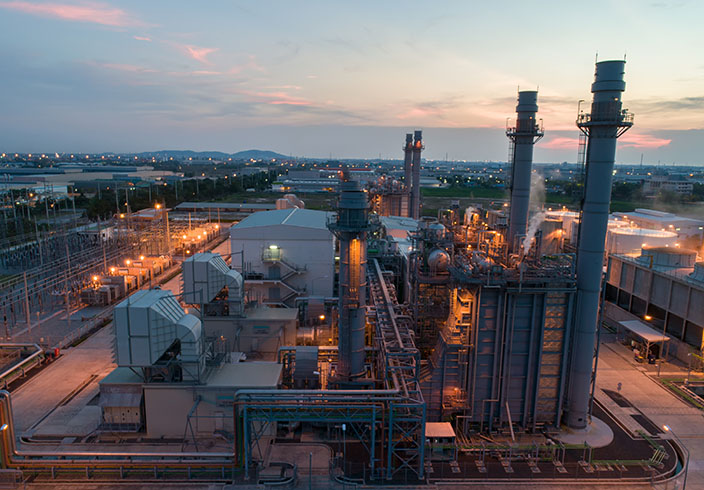Developments in recent months and years have made it abundantly clear that we need to move away from dependence on natural gas as quickly as possible. This applies in particular to energy-intensive industry, for whose processes this finite resource is often still essential. Companies need innovative solutions that meet their requirements in terms of security of supply and energy demand – and at the same time guarantee price stability. What options are already available to companies in terms of natural gas alternatives? And how sustainable are these solutions?
Future prospects for natural gas: why new paths are needed
CO2 and other climate-damaging gases are released both during the extraction and combustion of natural gas. For reasons of climate protection, it is therefore essential to switch to alternatives to natural gas for energy supply. At the same time, price fluctuations make long-term planning difficult for companies. Due to the gradual increase in the CO2 tax, the cost of natural gas will continue to rise in the future if companies do not switch their energy supply.
The political situation also shows how important it is to reduce dependence on natural gas. The Russian war of aggression against Ukraine has made it clear how quickly a precarious supply situation can arise. A transformation towards a renewable energy supply makes it possible to become independent of conflict-ridden supplier nations. One thing is clear: alternatives to natural gas are needed that work for industry in the long term.
Alternatives to natural gas for industry
There are already various approaches to replacing natural gas in the energy supply of industry. However, some of these differ greatly in terms of how climate-friendly, scalable and sustainable they are. What are the advantages and disadvantages of these alternatives?
LNG as a short-term replacement for Russian natural gas
To compensate for the loss of Russian natural gas supplies, Germany and the EU are importing more liquefied natural gas. This consists mainly of methane and is extracted from underground deposits or sandstone layers. It is abbreviated to LNG (liquefied natural gas) and should therefore not be confused with LPG (liquefied petroleum gas) and CNG (compressed natural gas). Switching from gaseous to liquid natural gas is straightforward for companies, especially with modern condensing boilers.
LNG is therefore a bridging technology that can be implemented in the short term in order to break away from dependence on Russia for energy supply. However, imported LNG causes almost ten times more greenhouse gas emissions than natural gas transported by pipeline – the long transport routes (e.g. from the USA) or extraction by fracking damage our environment.
Is biogas an alternative to natural gas?
Biogas is usually produced from food waste, damaged wood, sewage sludge, manure from agriculture or other biogenic waste. Alternatively, it is also possible to grow special energy crops for this purpose. Microorganisms decompose the organic material without the addition of air and produce raw biogas in the process. Only electricity is needed to control the plant. The added value is often created regionally by farmers or recycling companies, who then distribute the biogas via the natural gas pipeline network.
In order for the biogas to be used like natural gas, it must be refined and the methane content doubled. This is complex and expensive. In addition, only a few biogas plants are currently connected to the natural gas grid, which means that biogas is not yet a widespread alternative to natural gas.
Electrification: switch to electricity-based energy supply
The electrification of processes using renewable energies plays a key role in driving forward decarbonization in energy-intensive industries in particular. Switching to an electricity-based energy supply is an important lever, especially with regard to the required process heat – after all, the majority of demand here is still covered by fossil fuels. Replacing old gas-fired boilers with electric boilers is comparatively straightforward for companies. Energy storage systems can also help companies to decarbonise their process heat – and at the same time ensure the security of supply for their processes.
As electrification progresses, electricity consumption will increase significantly over the next few years. The consistent expansion of renewable energies is therefore a prerequisite for the successful and climate-friendly electrification of industry.
Potenzial von erneuerbaren Energien: Photovoltaik, Windkraft und Co.
In Germany, for example, 44 per cent of the electricity mix in 2022 consisted of renewable energies, according to information from the Federal Ministry for Economic Affairs and Climate Protection. This was followed by lignite in second place with around 20 per cent, then natural gas with 14 per cent, hard coal with 11 per cent and nuclear energy with 6 per cent. The advantages of an energy supply based on renewable sources are obvious. Renewable energies are available in almost unlimited quantities and can be generated locally. Further expansion will reduce Germany’s and also Europe’s dependence on energy imports from abroad.
However, their volatility is becoming a challenge for companies when it comes to ensuring a secure and reliable energy supply – especially with regard to complex industrial processes. Energy storage technologies help companies to utilise renewable energies to supply their production. They compensate for weather-dependent differences in power generation by storing unused electricity. This means that climate-neutral electricity is available at all times.
Green hydrogen as a natural gas alternative for industry
Renewable energies are also essential for the production of green hydrogen. Hydrogen is produced through the electrolysis of water: In the case of green hydrogen, this is done using electricity from renewable energy sources, making it emission-free. In principle, it can be used in many different ways, for example as a substitute for coal as a reducing agent in the steel industry, as a substitute for crude oil in the chemical industry or to heat furnaces in the glass, cement and steel industries.
However, the technology is not yet widely available and cost-effective. It is therefore more efficient in the current situation to use it only for processes that cannot be electrified or are very difficult to do so.
The suitable natural gas alternative for your company: The ThermalBattery™
As electricity demand increases, it becomes all the more important to use energy – especially from renewable sources – as efficiently as possible. Energy storage systems such as the ThermalBattery™ from ENERGYNEST can help to balance out fluctuations in energy generation by enabling energy to be stored and utilised at different times. The ThermalBattery™ stores energy in the form of heat in a special concrete inside the battery. This energy can be made available again as high-temperature heat or steam for production processes as required. This ensures a stable energy supply. In combination with a renewable energy source, the ThermalBattery™ becomes a sustainable and climate-friendly alternative to natural gas.
Are you interested in ENERGYNEST, or have any questions regarding our thermal energy storage solutions or our applications for your specific industry?
Don’t hesitate to drop us a line.



